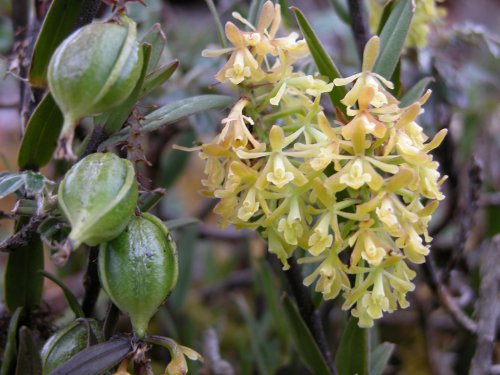

Epidendrum tenuicaule F.Lehm. & Kraenzl. 1899 GROUP Andean SUBGROUP Cuniculatum
Photo by Ecuagenera and their Ecuador Orchid Website
Drawing by © Jimenez, Hágsater & E.Santiago and The AMO Herbario Website

 LATER
LATER LATE
LATE
Common Name or Meaning The Thin Stemmed Epidendrum
Flower Size .6" [1.5 cm]
Found in Ecuador and northern Peru at elevations around 2500 to 3700 meters as a miniature to medium sized, cold growing lithophyte or epiphyte with branched, cane-like, terete, thin, main stem longest, upper branches progressively smaller stems arising from the subapical internodes of the previous stem and carrying articulate, distributed all along the stem, narrowly lanceolate, acute, dorsal keel, crenate margined leaves that blooms in the later summer through late spring on a terminal, arching-nutant, terete, dense, 16 to 20 flowered inflorescence with ovate, acuminate, shorter than the ovary floral bracts and carrying simultaneously opening, resupinate flowers.
"Epidendrum tenuicaule belongs to the GROUP Andean SUBGROUP Cuniculatum , which is characterized by the monopodial, branching hablt, adpressed leaf-sheaths, acute leaves, and 3-lobed lip. The species is recognized by the bushy, branching, short plants, narrow leaves, mostly less than .21" [5 mm] wide, the arching small inflorescence with greenish yellow, simultaneous flowers, the lateral lobes of the lip well developed, dolabriform, and a short nectary. It is very similar to Epidendrum ochricolor A.O.Hawkes which has wider leaves .2 to .4 [5 to 10 mm] and obliquely ovate lateral lobes of the lip. Epidendrum cuniculatum Schltr. has a deeper nectary, penetrating more than half the ovary, a larger, funnel-shaped clinandrium-hood with the margin sinuous, and very short, reniform, lateral lobes of the lip, with a sinuous margin. In Ecuador it has been confused wlth Epidendrum scabrum Ruiz & Pavón has very tall monopodial stems, with a relatively large, somewhat paniculate, arching-nutant, many-flowered inflorescence and much larger, wider leaves, to .52" [13 mm] wide. It grows in the same region as E. angustissimum Lindl. (syn. E. chortophyllum Schltr.) which forms a more open bush, and has linear-lanceolate, acuminate leaves to .14" [3.5 mm] wide, the rachis of the inflorescence longer, to 2.12" [5.3 cm] long and the lateral lobes of the lip semi-orbicular. It somewhat resembles E. soratae Rchb.f. which has infundibuliform leaf-sheaths, short stems produced from the subapical internodes of the previous stem, narrow, linear petals with an entire margin and a reniform lip, with a very small, emarginate midlobe and the margins entire." Hagsater etal 2006
Synonyms
References W3 Tropicos, Kew Monocot list , IPNI ; Icones Orchidacearum 7 Plate 712 Hagsater and Sanchez 2004 see recognition section; Icones Orchidacearum 7 Plate 727 Hagsater and Sanchez 2004 see recognition section; Icones Orchidacearum 7 Plate 774 Hagsater and Sanchez 2004 see recognition section; Icones Orchidacearum 8 Plate 892 Hagsater 2006 drawing ok; Icones Orchidacearum Vol 9 Plate 906 Hagsater & Sanchez 2007 see recognition section; Icones Orchidacearum 12 Plate 1233 Hagsater 2009 see recognition section; Icones Orchidacearum 17(1) Plate 1701 Hagsater & Jimenez 2019 See recognition section; Icones Orchidacearum 18(2) Plate 1870 Hagsater & Jimenez 2021 see recognition section
----------------------------------------------------------------------------------------------------------